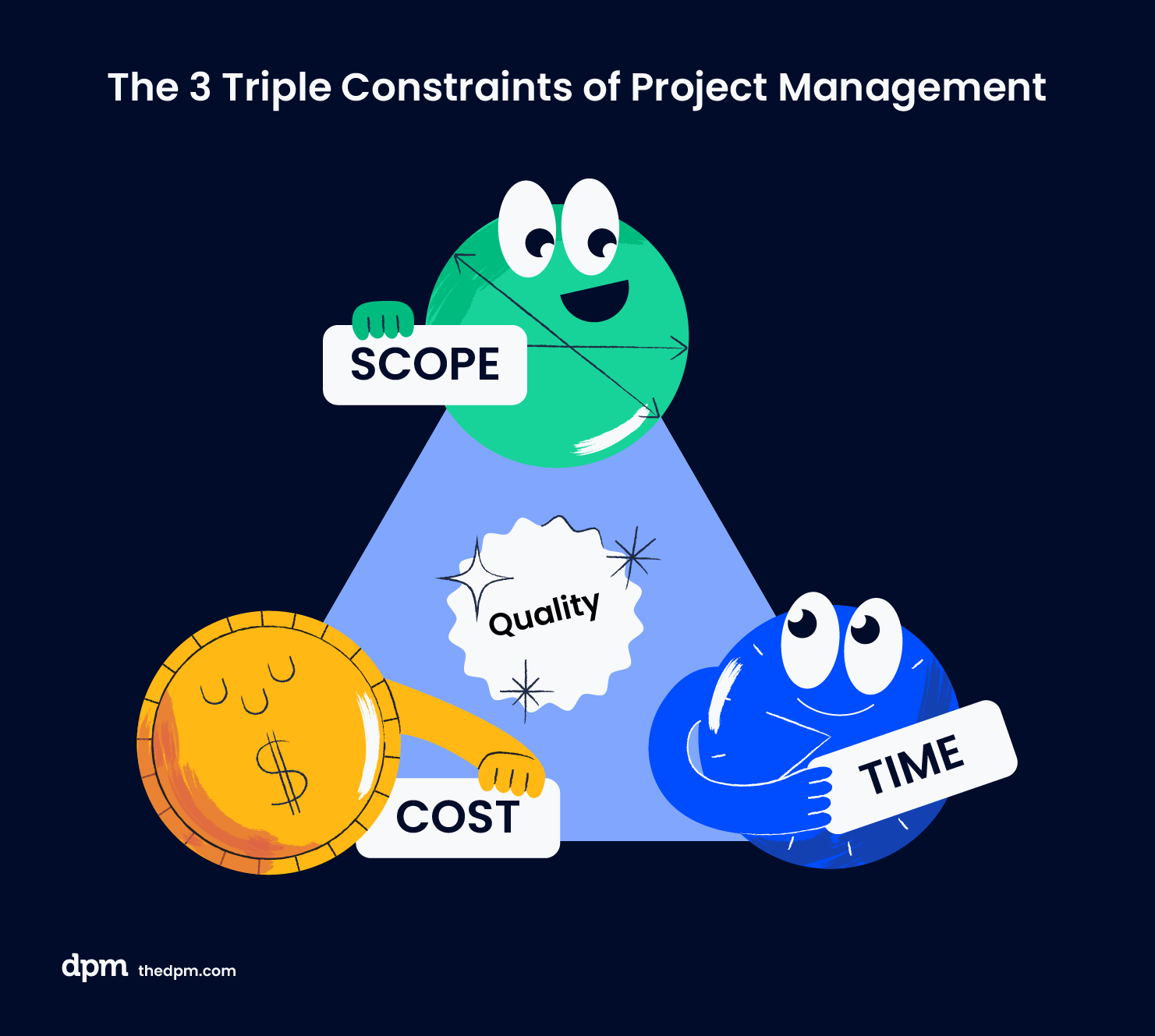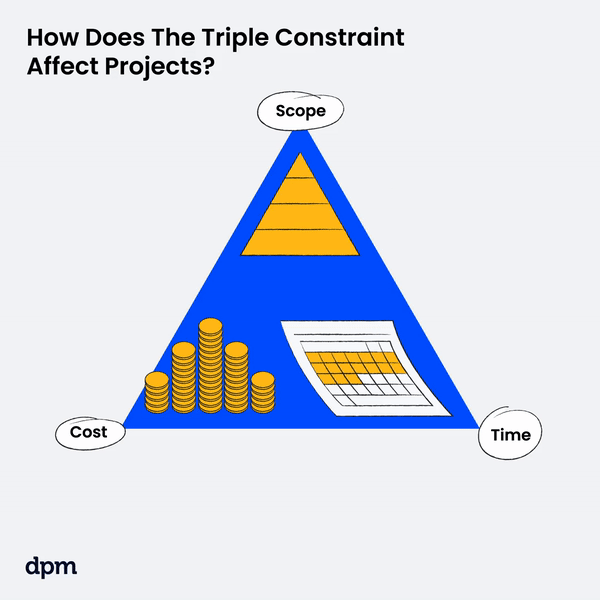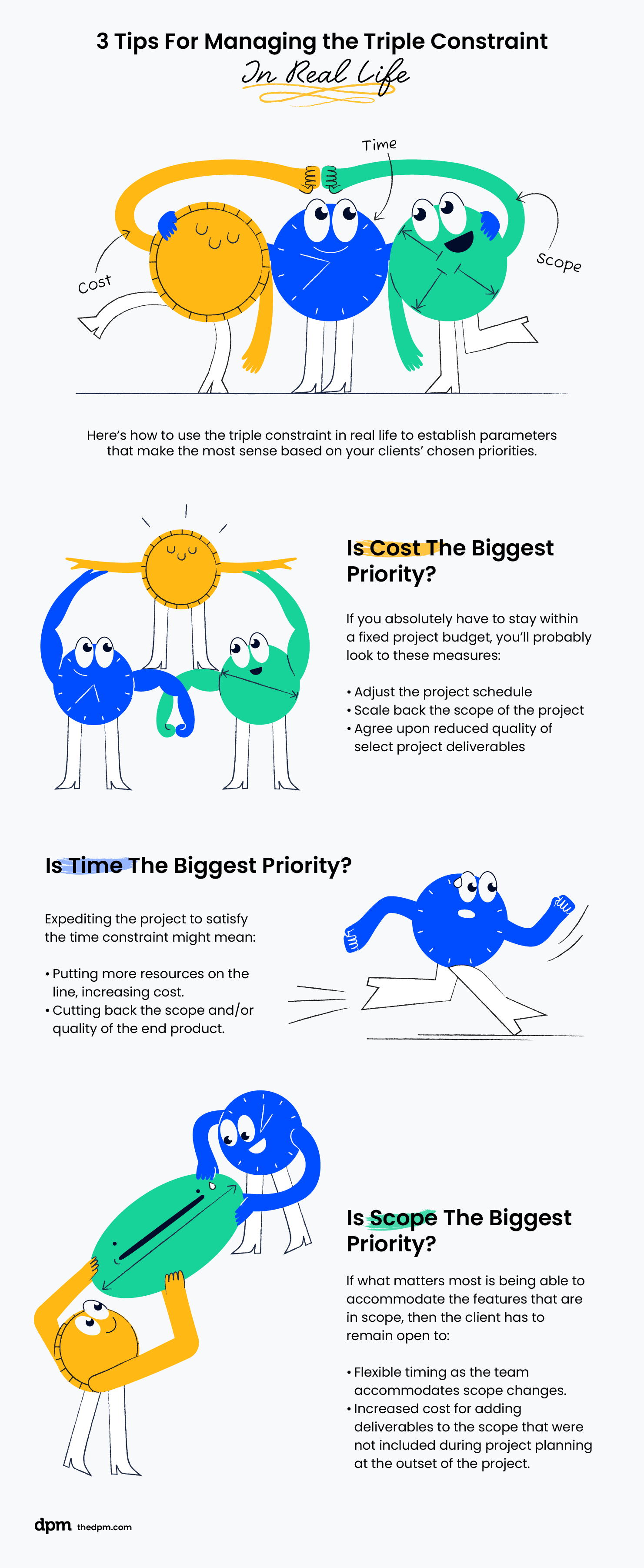The triple constraints in project management are scope, time, and cost.
- Scope: The deliverables and activities required to achieve a project's goals.
- Time: The schedule required to be followed to deliver a project on time.
- Cost: The budget, required to limit the resources used to deliver a project.
As project managers, we use the triple constraint model to explain (usually to clients and stakeholders) that they have a choice; "Do you want fast, cheap, or good?"
A project can be fast, cheap or good, but it can't be all three simultaneously. Quality will suffer.
As you'll learn in any good project management course, the reason for this is because the quality of work is constrained by a project's budget, timeline (or deadline), and scope. We can trade between constraints, but can't adjust one of the variables, or constraints, without impacting the others.
These project constraints, or variables, are tied to one another, and can be tricky to hold in tension and manage effectively, which is where project management software comes in handy!
What Are The Triple Constraints of Project Management?
The triple constraints are the three primary variables in project management and refer to the inextricable relationship between a project’s scope, time, and cost. They're also known as the iron triangle, or the project management triangle.

Scope
Project scope refers to what's being delivered: the extent, range, breadth, reach, confines, dimension, realm, gamut, spectrum, or spread of the work that’s to be done on a project.
It encompasses the sum of products and services to be provided, describing what’s being done and how much of it. You can learn more about scope statements and scopes of work in our statement of work guide (which includes a handy template).
Time
Project time is the duration or amount of time (usually expressed in number of hours) required or allocated to complete the project or tasks within the project.
Cost
Project cost refers to the resources—financial and otherwise—required for project execution. Costs might include labor, hardware, software, and other charges.
How Do Triple Constraints Work?
Simply put, if you make changes to one side of the triple constraint triangle, it also affects the other sides of the triangle. Choose fast, cheap, or good—but when you pick one, know it'll impact the others.
The premise of the triple constraints of project management is that the three factors of scope, project time, and cost are inextricably linked.

The most common triple constraint model places “quality” in the center of the triangle to illustrate that the quality of a project depends on the project’s scope, budget, and time spent.
How Triple Constraints Affect Projects
If you want to maintain a consistent level of quality (or, in geometry class, a consistent area within the triangle), making changes to one side of the triangle requires the other sides to adjust.
Math aside, the way the triple constraint affects projects is simple:
- If you’re going to ask for something to be delivered faster (time), you have to pay more (cost).
- If you’re trying to save some money (cost), sometimes you can achieve this by delivering a simpler product, or fewer things (scope).
The Fast, Cheap & Good Myth
In a competitive environment, it’s common to feel pressure to deliver something comprehensive as cheaply (and quickly!) as possible.
While that is possible in some scenarios, the project management triangle reminds us that, most of the time, projects cannot be simultaneously cheap, good, and fast. We have to know our priorities to help the clients and stakeholders decide “what’s gotta give”.

The triple constraint theory is especially helpful in conversations with clients, both when initially determining the scope of a project and when handling change requests along the way.
A Triple Constraint Example
So, how does this work in practice? Let’s take a website development project:
- Scope: eCommerce website
- Time: 6 months
- Cost: $500,000
Let's say that according to the original statement of work, the client agreed to supply content from their team, including SEO-friendly product descriptions.
But they’ve recently learned that their team doesn’t have bandwidth to produce the content, and so they’re asking your project team to do it instead.
You can help (and adjust the project scope)
Although you might like to simply say yes to this request, and be nice and helpful, the iron triangle reminds project managers that saying yes comes with consequences.
We can’t increase project scope and do that extra content copywriting without factoring in its relationship with time and cost.
Of course, the client wants this extra work for free. They would prefer to change the scope without the time or cost of the project being impacted (this is a whole issue in and of itself—see my post on managing scope creep).
A savvy project manager understands the dynamic between scope, time, and cost—and you know that trade-offs are inevitable. To deliver a successful project, the project manager must help key project stakeholders understand this dynamic, too.
How to explain the impact of changes
So, how do you navigate that conversation? The key is not to say no to the request outright. Of course, anything is possible, you're a project manager!
They key is to say, “We could do it, and change…”
- the project schedule, which will need to shift back a week OR
- the scope of another deliverable, or functionality OR
- the client needs to fund an extra week of work
You know best which lever to pull to get your client to agree. If they still aren’t getting it, whip out the diagram from this article and explain that quality suffers if the constraints change (as do the chances of project success). That tends to spook ‘em.
How To Use The Triple Constraint In Conversations About Your Projects
Although simplistic, the triple constraints of project management are often a useful way to set, and reset expectations of what's feasible to deliver or adjust within the constraints of a project's scope, cost, and time.
Here’s how to use the triple constraint model in conversations with clients about changes to project cost time and scope and tips to establish a go forward plan for the project based on your clients’ priorities.
Is Cost The Client's Biggest Priority?
If you absolutely have to stay within a fixed project budget, then the client may need to be more flexible on timeline and scope. With delivering on budget as the biggest priority, it’s likely that only the most business-critical change requests will be approved.
So, when cost conversations come up, either to reduce the budget or not provide additional budget, you’ll need to:
- adjust the project schedule
- scale back the scope of the project
- agree upon reduced quality of select project deliverables
How to deal with a change in cost and budget
When cost and sticking to the budget is a priority, you should take a moment to set yourself up with the right time tracking tools: use past project reports to make accurate time estimates and carefully track team member hours to make sure you’re staying on budget, schedule and hitting milestones as the project progresses.
When adjusting scope, you should also update your statement of work to redefine the scope and quality of project deliverables, and be sure to adjust tasks in your task management software.
Is Time The Client's Biggest Priority?
In cases where the deadline matters most, then more flexibility will be required with respect to the cost and/or scope.
Expediting the project to satisfy the time constraint might mean:
- putting more resources on the line, increasing cost
- cutting back the scope and/or quality of the end product
How to deal with a change in timeline
When sticking to the timeline, or expediting delivery is a priority, you should use a Gantt chart to create an updated project timeline and detailed work breakdown structure (WBS) and illustrate how the project schedule and deliverables will need to be adjusted.
It's important not just to create a timeline in isolation but to use resource management software, to ensure you can allocate the resources you need to delivery the project, monitor the project team’s capacity, resource utilization, and performance for projects, clients, and individuals.
Is Scope The Client's Biggest Priority?
If scope matters most, because the client needs flexibility to add features throughout the project, then it impacts the project timeline and cost. This is known as scope creep when scope is added by the client, or gold plating if it's done by the project team.
If what matters most is being able to accommodate the features that are in scope, then the client has to remain open to:
- flexible timing as the team accommodates scope changes
- increased cost for adding deliverables to the scope that were not included during project planning at the outset of the project
How to deal with a change in scope
When additional scope and deliverables are a priority, similarly to the changes to timeline and cost, you'll need to update the statement of work, the budget and project schedule as well as team tasks and resource plan.
3 Actionable Tips For Managing The Triple Constraint
Here's a quick visual overview and guide of how to manage the triple constraint in real life.

Beyond The Triangle: Why The Triple Constraints May Be An Octagon
Despite its longevity, opinions vary as to the accuracy and usefulness of the project management triangle. Some theories have stuck with the triangle concept but changed the types of constraints on each side. Regardless of the varying perspectives, every PM knows that managing a project is always more complex than the 3 iron triangle variables suggest, it's probably more like an octagon.

The Project Management Institute (PMI) agrees. In its latest version of the Project Management Body of Knowledge (PMBOK), PMI recognizes that project managers usually deal with more than three constraints that may shift throughout the project life cycle. Sample constraints might include resources, quality standards, sustainability guidelines, or regulatory compliance requirements.
Despite the added complexity, the triple constraint model is still a great way to conceptualize the relationships between the high-level dynamics involved in project management.
Need expert help selecting the right Project Management Software?
If you’re struggling to choose the right software, let us help you. Just share your needs in the form below and you’ll get free access to our dedicated software advisors who match and connect you with the best vendors for your needs.
What's Next?
Interested in refining your skills related to the triple constraints? Check out expert-created training options from our DPM School.




